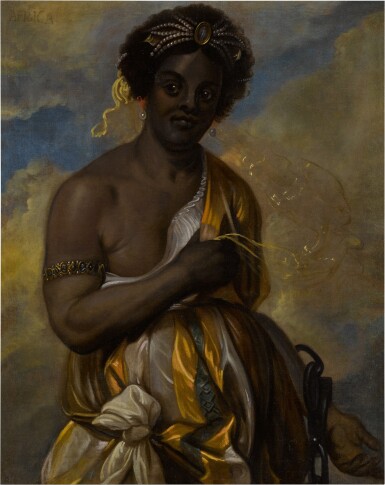
Jan Boeckhorst
Allegory of Africa
Lot Closed
January 28, 03:24 PM GMT
Estimate
40,000 - 60,000 USD
Lot Details
Description
Jan Boeckhorst
Münster or Rees circa 1604 - 1668 Antwerp
Allegory of Africa
inscribed upper left: AFRICA
oil on canvas
canvas: 41⅓ by 32¼ in.; 105 by 82 cm.
framed: 48¼ by 40 in.; 122.6 by 101.6 cm.
A black woman is depicted three-quarter length before a cloudy, luminous sky with her right arm drawn across her breast. She is wearing a headdress of white pearls inset with a miniature of a winged Amor, a bejeweled armlet, a silk dress striped in white, gold and green silk drawn into a knot and worn over a Venetian-style white chemise, leaving her right shoulder exposed. In her right hand she holds a transparent gauzy veil emanating from her headdress, forming a counterpoint to the heavy chain which manacles her left arm.
Around 1650, Jan Boeckhorst executed at least two versions of the present compsotion. One is part of a series from German private collection illustrating the allegorical subject of the Four Continents, while the other is in the Hohenbuchau Collection.1 The present painting appears to be an autograph version by the artist, and belongs to a different set from the two discussed.2
In Elizabeth McGrath’s view, Boeckhorst has created an original conception of a black woman.3 She concludes that the image is unique among representations of the Continent in this period, further speculating that the chain worn by Africa might be an allusion to "the slavery practiced within and upon black Africa."4 However during this period the overt reference can hardly have been to the Atlantic slave trade: rather it denotes the enslavement of Africans by the Turks.5 The specific source for Africa is, according to McGrath, Titian’s Portrait of Laura Dianti, Mistress of Alfonso d’Este, with a Black Page. This painting could have been known to Boeckhorst through an engraving by Aegidius Sadeler II (1570-1629). Another source of inspiration could have been the print of Agrippine Sibille, from a set of twelve engravings by Gilles Rousselet (1610-1686) and Abraham Bosse (circa 1601-1676) after Claude Vignon (1593-1670) that was published around 1635-1640 and copied by Pieter II de Jode (1606-1674) in Antwerp.6
1. M. Galen, Johann Boeckhorst : Gemälde und Zeichnungen, Hamburg 2012, pp. 126- 136, cat. nos. 34-40.
2. Elisabeth McGrath (Warburg Institute) as well as Boeckhorst expert Maria Galen have previously endorsed the attribution on the basis of photographs in 2017.
3. E. McGrath, ‘Sibyls, Sheba and Jan Boeckhorst’s ‘Parts of the World’, in: Florissant : bijdragen tot de kunstgeschiedenis der Nederlanden (15de - 17de eeuw) : liber amicorum Carl Van de Velde, Brussels 2005, pp. 359-366.
4. E. McGrath 2005, p. 366.
5. E. McGrath 2005, pp. 361-362.
6. E. McGrath, ‘Jacob Jordaens and Moses’s Ethiopian Wife’, in: Journal of the Warburg and Courtauld Institutes 70 (2007), pp. 247-285, p. 273
You May Also Like










